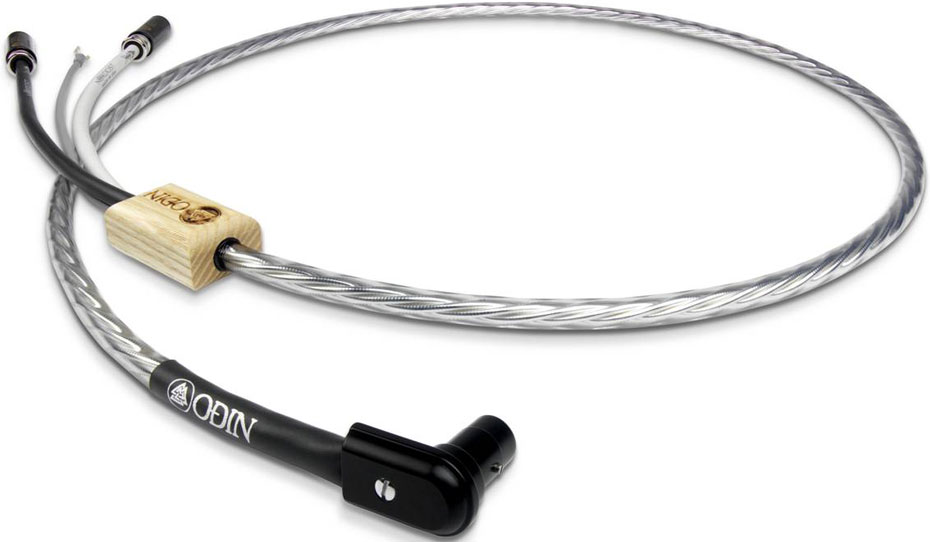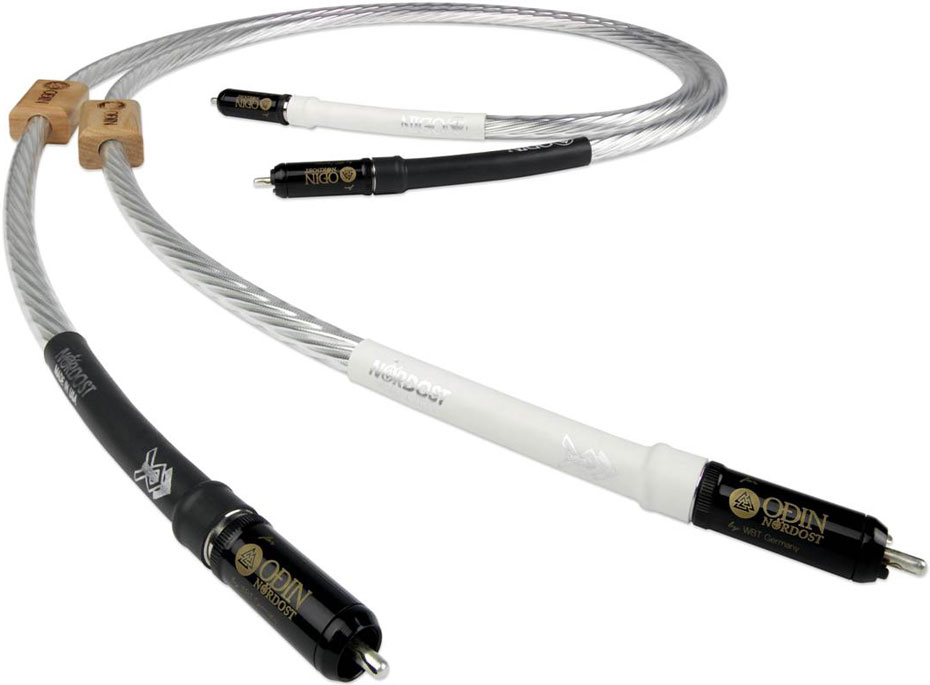Introduction
I received an Odin tone arm cable and a pair of interconnects for review several months ago. Both had been thoroughly broken in at the factory. I was somewhat taken aback when the UPS driver showed up with a nondescript brown cardboard box no larger than a cigar box. One does not normally expect to receive $26,000 in tone arm lead and a pair of interconnects in a plain brown box with minimal packaging, such as some bubble wraps. Whether or not it makes sense in terms of security and shipping costs, it certainly makes for a humorous moment when I show non-audiophile friends the box and mention in an off-hand manner the value of the contents. Perhaps I should have titled this article “Great things sometimes come in small packages,” but I am getting ahead of myself. (Per Roy Gregory of Nordost, “the review samples are dispatched without packaging for cost and security reasons. Retail customers receive each cable in a nice velvet-lined wooden case, complete with warranty card, instructions etc. Personally speaking, I feel that this should change and that reviewers should receive product exactly as the customer does. The policy is a hangover from the early days of the company, ironically, long before they made anything as aspiring as the Odin. In mitigation I should however point out that we do prefer to cable a reviewer’s entire system, which would mean in most cases, upwards of a dozen identical wooden boxes! Methinks a middle ground might be sensible.” -CS)
Description
The conductor used in both Nordost’s Odin and Valhalla interconnects and phono cable is silver plated copper. According to Roy, “the Valhalla uses a single micro mono-filament construction, with a single thread of FEP wound around each conductor, spacing it from the FEP sleeve in a virtual air gap. Odin differs in using a twisted pair of threads. This arrangement increases the air gap, improves the damping and further reduces surface contact between the conductor and the insulation. It is the only product family in the range that uses the unique DMMF construction throughout.” The tubular Odin cables are constructed of individually shielded conductors, each shield apparently formed from linked flat rings. The unusual appearance of the cable reflects the silver plated copper ribbon used and the complex and innovative construction. As you might guess, this degree of attention to detail only comes at a price.
Roy also has the following to add on the TSC shielding: “The TSC shield is another unique Nordost technology. It employs a spiral wound foil ribbon, but rather than simply laying the edges one on top of the next, they are actually folded and ‘crimped’ in a fully lapped arrangement that makes them electrically and mechanically continuous – hence the particular appearance. As you might imagine this is a complex and time consuming task, but the end result is a shield that is as electrically effective as a solid copper tube (the most effective shield there is) whilst being nearly as mechanically flexible as a woven braid. It also uses less material than either of those options, which also aids performance.”
The dedicated phono cable is unique in my experience. Most manufacturers simply attach a ground wire to a pair of their interconnects for use as a phono cable, failing to take into account the vast differences between the signal generated by a moving coil cartridge and other sources. This is most apparent in comparing signal levels. A CD player will typically generate a 2-volt signal while a cartridge may generate a signal in the millivolt region. Add to this the effect of the RIAA equalization curve and you begin to see that the cartridge signal input indeed requires special handling. Nordost combines the conductors for each channel in a single cable to maintain symmetry carefully shielding the resultant bundle.
Listening
About ten years ago, I auditioned as many tone arm cables as I could get my hands on. The end result of that process was my purchase of the Valhalla. That one piece of cable is one of two things, the other being my Rockport turntable, which has remained constant in my system over the ensuing ten years. Everything else has come and gone, many things several times. This should suggest that anything which dethrones the Valhalla would need to be very special.
Initially, I had intended to play one side of a familiar piece of music using the Valhalla and then switch to the Odin and replay the same cuts trying to discern any appreciable differences. About a minute into the first record, Synchronicity by Police (1983), it became apparent that no such back and forth switching was really necessary as the two cables, Valhalla and Odin, sounded quite different. This is not to say that certain familial similarities do not exist between them. Both are quick, uncluttered and seamless, both are extremely coherent with respect to timing and dynamics and both create a very believable soundstage.
In comparison, the Odin is better able to recreate space and is superb at differentiating the sounds of not only different drumheads, but also in differentiating between the sound of the drumhead and that of the space immediately beneath the skin. With the Odin, highs are clearer and more distinct without being at all strident or calling attention to themselves. It has what I would describe as the jump factor. It is more dynamic than the Valhalla in that it has a significantly enhanced ability to accelerate from very soft to very loud. Using an auto analogy, this is going from a normal Mustang to a Shelby GT-500. Imaging is also somewhat better, but this has always been a strength of the Valhalla. I think that I have said before that I always found the Valhalla somewhat less tonally complex than would be ideal. This is clearly not the case with the Odin. Harmonic definition and texture are noticeably improved. While this is more than a mere change in tonal balance, it clearly does affect that balance. You hear this in two ways. While there is clearly more information in the highs, they are at the same time a bit softer and more liquid. The mids are at the same time more prominent but extremely well balanced with the highs and harmonically more complex. As mentioned, the Odin is also more dynamic.
I did this comparison on two other disks, Peter Gabriel’s Passion of Christ and Weather Report’s Mysterious Traveler. I should stop long enough to say that the Gabriel is absolutely superb. On the Gabriel, again, the balance between the mids and the highs was uncanny. I think that the real point here is that the Odin pulls you into the music with what appears at least to these ears to be a more believable illusion that you are listening to a live performance. On the Gabriel LP, I was struck by the ability of the Odin to convey complex vocal harmonies while at the same time being able to separate out the individual voices that comprised the harmony. Often on other interconnects the individual singers are indistinguishable as or alternately, you hear each voice but they never seem to be singing together.
On the Weather Report -which is one of Columbia’s typically bright, mid-seventies issues – textures were clean and very clear. The music was all there and very involving even if the brightness was not completely tamed. On the Valhalla, the brightness predominated and the complex textures were more difficult to untangle. In particular the second cut on the first side was excellent with very much of a “you are there feel” to it. Ironically, it was easier to tell that the first cut – a real masterpiece of studio wizardry in its day that includes interlineated applause – was live.
While the Odin is truly superb, it can’t undo real engineering/pressing problems or make a bad record sound good. Thus, I would not call it overly euphonic, but it did bring in some midrange texture and warmth that were welcome.
Conclusion
The Odin tone arm cable is far superior to any other phono cable I have auditioned. It is roughly equivalent to a major equipment upgrade, say for instance replacing your transistorized outboard phono stage with a truly excellent tube stage. In comparison to the Valhalla, the Odin: 1) is better able to recreate the space of the recording venue, or in some cases the lack of any spatial cues, 2) is particularly good in differentiating among different drum heads, 3) highs are clearer and more distinct without any hint of stridency, 4) imaging is better with excellent focus and specificity, 5) dynamics in the mids are better but the real achievement is that dynamics are consistent throughout the frequency range with no particular frequency band singled out, 6) bass is astonishing in its power and ability to plum the depths, and 7) retrieval of low level detail is absolutely superb.
I know it has become a cliché but I really am hearing things on well known recordings that I had not heard in the past. I should also note that I have always found the Valhalla to be a touch lacking in harmonic complexity. This is certainly not the case with the Odin. If you wanted to put one word or phrase on it, I’d say it’s the total lack of restraint that sets the Odin apart from other cables. You never feel that the signal or the music is struggling to get through.
While adding an additional Odin interconnect downstream will extend that effect, I should note that the improvement had by replacing the tone arm cable was more significant than the replacement of the cable from my outboard phono stage to my preamp. What adding additional Odin did make clear was the inherent coloration in my reference cables. Even though it will probably require a loan to do so, I am purchasing the review sample.
- (Page 1 of 1)


